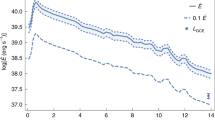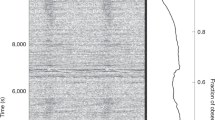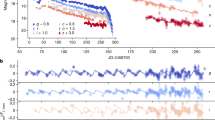Abstract
The bright galactic bulge source GX5–1 (4U1758–250) has recently been observed1 to exhibit quasi-periods between 25 and 50 ms, with a correlation between the corresponding frequencies f and the count rate I given by dlog f/dlog I ∼ 2.5. This is the first source observed to exhibit such a phenomenon. We propose here that this behaviour results from fluctuations in accretion rate onto a millisecond pulsar, which has been spun up by accretion to its steady-state spin rate. According to models that use spin-up by accretion to bring the neutron stars to steady-state fast short periods, galactic bulge sources are likely progenitors of millisecond pulsars2–10. After steady state is achieved in these systems, accretion may continue without further spin-up, so that for a substantial fraction of the lifetime of a galactic bulge X-ray source, the neutron star may already be spinning rapidly at the equilibrium spin. The behaviour of GX5–1 can be explained in terms of deviations from this equilibrium state resulting from changes in the accretion rate M; GX5–1 may, therefore, be a new millisecond pulsar.
This is a preview of subscription content, access via your institution
Access options
Subscribe to this journal
Receive 51 print issues and online access
$199.00 per year
only $3.90 per issue
Buy this article
- Purchase on Springer Link
- Instant access to full article PDF
Prices may be subject to local taxes which are calculated during checkout
Similar content being viewed by others
References
van der Klis, M. et al. IAU Circ. No. 4303 (1985).
Alpar, M. A., Cheng, A. F., Ruderman, M. A. & Shaham, J. Nature 300, 728–730 (1982).
Radhakrishnan, V. & Srinivasan, G. Curr. Sci. 51, 1096–1099 (1982).
Fabian, A. C., Pringle, J. E., Verbunt, F. & Wade, K. A. Nature 301, 222–223 (1983).
Ruderman, M. A. & Shaham, J. Comments Astrophys. Space Sci. 10, 15–22 (1983).
Helfand, D. J., Ruderman, M. A. & Shaham, J. Nature 304, 423–425 (1983).
Ruderman, M. A. & Shaham, J. Nature 304, 419–421 (1983).
Joss, P. C. & Rappaport, S. A. Nature 304, 419–421 (1983).
Paczynski, B. Nature 304, 421–422 (1983).
Savonije, G. Nature 304, 422–423 (1983).
Alpar, M. A. & Shaham, J. IAU Circ. No. 4306 (1985).
Ghosh, P., Lamb, F. K. & Pethick, C. J. Astrophys. J. 217, 578–596 (1977).
Perreault, P. & Akasofu, S.-I. Geophys. J.R. astr. Soc. 54, 547–573 (1978).
Akasofu, S.-I. Planet. Space Sci. 27, 425–431 (1979).
Akasofu, S.-I. Planet. Space Sci. 27, 1055–1062 (1979).
Sonnerup, B. U. Ö. J. geophys. Res. 79, 1546–1549 (1974).
Ghosh, P. & Lamb, F. K. Astrophys. J. Lett. 223, L83–L87 (1978).
Ghosh, P. & Lamb, F. K. Astrophys. J. 234, 296–316 (1979).
Elsner, R. F. & Lamb, F. K. Astrophys. J. 278, 326–344 (1984).
Alpar, M. A., Lamb, F. K. & Shaham, J. Nature (submitted).
Lewin, W. H. G. & Joss, P. C. in Accretion-Driven Stellar X-ray Sources (eds Lewin, W. H. G. & van den Heuvel, E. P. J.) 41–115 (Cambridge University Press, 1983).
Li, F., Joss, P. C., McClintock, J., Rappaport, S. & Wright, E. L. Astrophys. J. 240, 628–635 (1980).
Tawara, Y. et al. Nature 299, 38–41 (1982).
Author information
Authors and Affiliations
Rights and permissions
About this article
Cite this article
Alpar, M., Shaham, J. Is GX5 – 1 a millisecond pulsar?. Nature 316, 239–241 (1985). https://doi.org/10.1038/316239a0
Received:
Accepted:
Issue Date:
DOI: https://doi.org/10.1038/316239a0
This article is cited by
-
Understanding the inner structure of accretion disk in GX 17+2: AstroSat’s outlook
Journal of Astrophysics and Astronomy (2021)
-
Investigating the coronal structure by studying time lags in the Atoll source 4U 1705-44 using AstroSat
Astrophysics and Space Science (2021)
-
Accretion, Outflows, and Winds of Magnetized Stars
Space Science Reviews (2015)
-
On the origin of jets from disc-accreting magnetized stars
Computational Astrophysics and Cosmology (2014)
-
Fast Variability from Black-Hole Binaries
Space Science Reviews (2014)
Comments
By submitting a comment you agree to abide by our Terms and Community Guidelines. If you find something abusive or that does not comply with our terms or guidelines please flag it as inappropriate.



